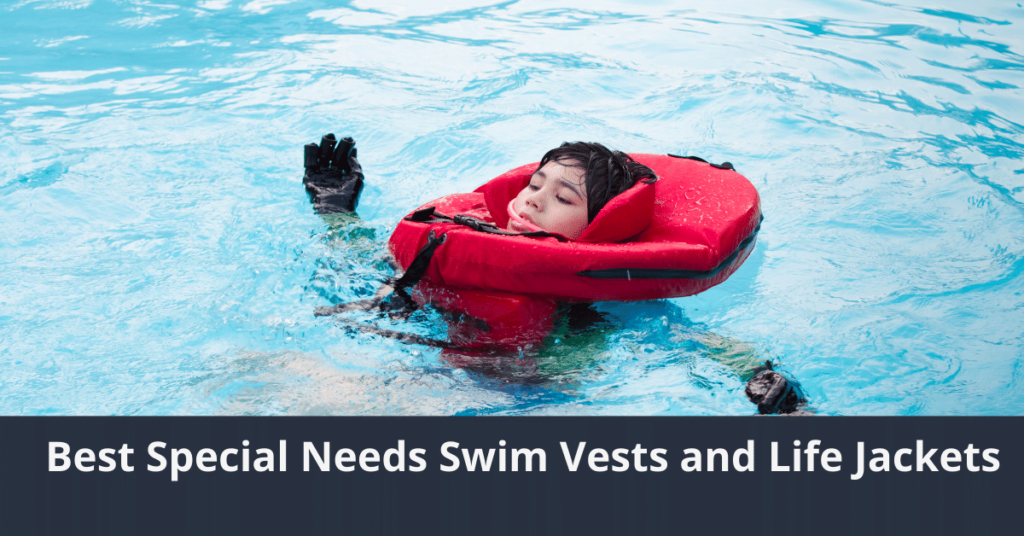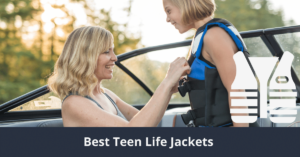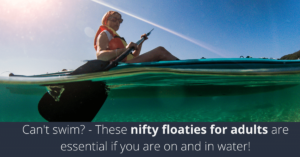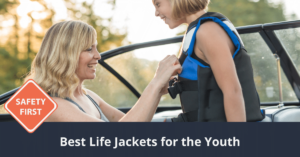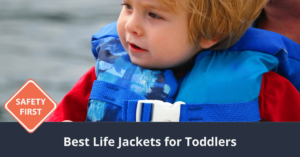Swimming with special needs can present unique physical challenges. The great news is that we live in an age of innovation. There are dozens of products designed to help those who are differently-abled to enjoy the water while staying safe.
That’s why we’ve compiled a list of special needs swim vests and life jackets reviews. These reviews feature products for those who have limited mobility and need significant support. They also feature products for those who just need some helpful positioning in the water.
In addition to reviews, we will also go over what you should look for in a special needs swim vest. No two people are alike, so it can be challenging to find the perfect flotation device. We will also discuss the features of the best special needs life jackets and swim vests and what makes them extra safe.
These products have many excellent features, such as additional neck support or unique balance technology that keeps the wearer upright in the water. Whatever your needs in a swim vest, this helpful guide will ensure that you can make the best choice to stay safe and enjoy the water.
Everything you will learn here
- The Best Special Needs Swim Vest and Life Jackets Reviews – Editor’s Picks
- 1. Wet Vest II
- 2. Head Float by Danmar
- 3. Sectional Raft by Danmar
- 4. Dolphin Float System by Danmar
- 5. My Pool Pal Flotation Swimwear
- 6. Stearns Safety Puddle Jumper
- 7. Sprint Aquatics Three-Piece Belt Float
- 8. Personal Floatation Device-Adapted PFD-A
- 9. Lj-A Life Jacket Adapted
- 10. Lj-V Life Jacket Adapted
- Special Needs Swim Vests and Life Jackets Buyer’s Guide – Knowing What to Look for
- Features
- Types of Special Needs Swim Vests and Life Jackets
- Benefits of Using Special Needs Swim Vests
- Drawbacks of Using Special Needs Swim Vests
- Using Your Special Needs Swim Vest The Right Way
- Step-by-Step Installation
- Maintaining Your Special Needs Swim Vest
- Safety Tips
- Best Special Needs Swim Vests and Life Jackets Comparison Chart
- Wrap-Up
The Best Special Needs Swim Vest and Life Jackets Reviews – Editor’s Picks
Here are the best special needs swim vest and life jacket reviews for the new year. These products are in no particular order of superiority.
1. Wet Vest II
The Wet Vest II fits around the body like a regular bathing suit. It helps swimmers stay supported in deep water, providing them additional buoyancy while also letting them swim unencumbered. The Wet Vest is perfect for swimmers practicing water rehabilitation. It supplies gentle support while helping them maintain control and work their muscles.
The Wet Vest comes in a variety of sizes, from child up through adult. Its unique design keeps the swimmer’s head above the water even when they are not treading water. It also keeps swimmers in a vertical position to avoid extra strain on the neck and back muscles.
The Wet Vest is an excellent choice for swimmers with mild to moderate special needs, especially those who do water exercises as a means of improving strength.
Pros
- Helps keep swimmer’s head above the water
- Reduces strain on neck and back by positioning vertically
- Provides gentle exercise without pain
- Helps keep swimmers warm in the water
Cons
- May not provide enough support for some individuals
- The neck is not physically supported
- Not for timid swimmers or for those with limited mobility
2. Head Float by Danmar
The Head Float by Danmar gently lifts and supports the head above the surface of the water. At the same time, it lets the hands stay free for water mobility. The Head Float straps around the neck for gentle support without putting a strain on the spinal cord.
The Head Float is ideal for swimmers with reflex domination, especially those who need additional trunk support. It provides support in the water without hampering freedom or movement.
It is not inflatable, so it will continue providing support if it is torn or punctured. This provides additional peace of mind in the water.
Buyers can customize the Head Float with a beveled headrest. It is an excellent option for individuals with shorter necks.
Pros
- Help keep head above the water
- Provides support without straining neck
- Allows swimmer to maintain independent movement of limbs
- Customization options
- Cannot be punctured
Cons
- Some swimmers may not like having their neck constrained
- Does not support wearers over 175 lbs
- May limit some movement
3. Sectional Raft by Danmar
The Sectional Raft by Danmar isn’t technically a life jacket. We have included it on this list because it is similarly worn on the body to provide support and flotation in the water. Unlike other special needs swim vests that serve to hold the swimmer’s head high above the water, the sectional raft lets them recline. That allows water to flow around them.
Because of this, swimmers using the sectional raft might need assistance, especially if they are non-ambulatory. However, this positioning lets them relax in the water and enjoy a more natural experience.
The raft holds the head above water. Meanwhile, the supports on the back prevent swimmers from rolling over. The bottom folds can be folded or unfolded to provide additional support or mobility for the lower limbs.
Pros
- Holds head above water
- Allows swimmer to relax in a reclined position
- Prevents rolling
- Adjustable settings to provide more or less support for legs
Cons
- Does not hold head clear of the water — water can flow around the head
- May require supervision
- Exposes parts of the body to air, which may cause chills
4. Dolphin Float System by Danmar
The Dolphin Float System by Danmar is ideal for swimmers who can support their head and neck but still need help steadying or balancing themselves in the water. The Dolphin Float helps support and balance swimmers while providing them with freedom and mobility.
The large chest pad helps lift the wearer out of the water. It also prevents rolling and becoming stuck under the surface. Meanwhile, the strap crosses between the legs to keep the system securely in place.
Users can also remove the front chest pad if they do not need it. The Dolphin Float System is ideal for those who need moderate additional support while still moving freely through the water. There are also customizable options. The Dolphin Float comes in a range of sizes.
Pros
- Provides simultaneous support and mobility
- Prevents rolling
- Users can remove the front chest pad
Cons
- Does not support the head or neck
- May feel bulky or cumbersome
- May limit some mobility
5. My Pool Pal Flotation Swimwear
My Pool Pal Flotation Swimwear combines bathing suits with the best in flotation innovation. This range of unique swimwear has flotation devices built directly into the suit, so the wearer always has additional water support.
This swimwear comes in a range of styles and sizes, from regular one-pieces to rash guards and more. As the wearer becomes more confident in the water, they can remove the flotation inserts. This converts the suit to a regular bathing suit. There is also the option to remove some of the inserts and leave others, still providing some support.
My Pool Pal Flotation Swimwear also helps the wearer position themselves correctly in the water. This can improve physical strength while also keeping the head and neck clear of the surface.
Pros
- Helps position wearer correctly
- Keeps head above water
- Users can adjust inserts
Cons
- No or few options for adults
- Does not provide the strong support that some swimmers might need
- Does not prevent rolling
6. Stearns Safety Puddle Jumper
The Stearns Safety Puddle Jumper is well-known. It is an excellent choice for children and youth both abled and differently-abled. With a safety design approved by the United States Coast Guard, parents everywhere have felt at peace knowing their child was safe in the water.
Puddle jumpers are excellent because they provide support and buoyancy in the water while allowing children to move independently. However, it is vital to note that users should always have supervision. Puddle jumpers do not hold the wearer’s head out of the water. Although they provide additional support, this never replaces adequate supervision for any child.
However, they are excellent for teaching children to swim and providing support in the water while still allowing wearers to move freely.
Pros
- Provide moderate support
- Allow freedom of movement
- Approved by United States Coast Guard
Cons
- Still require parent or guardian supervision
- Not available for adults
- May not provide enough support for some swimmers
(We also have other recommendations of puddle jumpers on Best Puddle Jumpers)
7. Sprint Aquatics Three-Piece Belt Float
The Sprint Aquatics Three-Piece Belt Float provides gentle support while leaving the arms free to move in the water. The simple belt clasps around the waist. This provides support without a bulky or cumbersome jacket.
The three-piece belt float is made of foam with a latex-free coating. This means that the belt will continue to offer support even if it is torn or punctured.
This belt is ideal for those who need moderate water support but still want to move freely. It is also perfect for swimmers who don’t like wearing life jackets or find them uncomfortable. However, it might not be suited for anyone who needs significant head or neck support, since it does not hold the head out of the water.
Pros
- More comfortable than a life jacket
- Offers more mobility
- Made of puncture-safe foam
Cons
- Does not hold head out of the water
- May not provide enough support for some swimmers
- May feel bulky or cumbersome
8. Personal Floatation Device-Adapted PFD-A
The Personal Flotation Device-Adapted PFD-A provides support for swimmers with significant physical needs. It keeps them reclined comfortably on their back, holding their head and face out of the water while letting them enjoy the feeling of natural swimming.
Wearers can propel themselves with their limbs without needing to support themselves vertically. This device provides more stability even than standard swim vests for special needs individuals. It supports the head, neck, and trunk while allowing the limbs to flow freely.
It also holds wearers in such a way as to provide additional support in the event of involuntary convulsions or jerking, or even loss of consciousness. Wearers should never use the Personal Flotation Device-Adapted PFD-A without supervision.
This flotation is available in infant sizes up to 190 lbs.
Pros
- Provides secure trunk and neck support
- Lets wearer propel themselves with limbs
- Keeps face and head out of water
Cons
- Not intended for those who can put themselves vertically in the water
- Some wearers may be uncomfortable with a vest around the neck
- Sizing does not go above 190 lbs.
9. Lj-A Life Jacket Adapted
The Lj-A Life Jacket Adapted helps hold the wearer vertically in the water. Their head is lifted above the surface of the water and held in place with gentle supports. This also provides neck and back support to keep the wearer comfortable.
Wearers can easily swim on their back or stomach. But the Lj-A Life Jacket Adapted’s balance technology also protects them another way. If they go underwater unexpectedly, it immediately brings them back above the surface. This makes it an excellent choice to keep swimmers safe while allowing them maximum autonomy. It can also help tentative swimmers become more comfortable in the water.
The jacket’s special harness distributes weight evenly for maximum comfort. There are also customization options that allow you to add to or change the padding to make the harness more comfortable.
Pros
- Keeps head above the water
- Evenly distributes weight for maximum comfort
- Allows swimmer to move freely
- Instantly brings head above the surface
Cons
- Only for those who cannot lower themselves vertically into the water
- Not suited for those who have convulsions or involuntary movements
- Some wearers may find the neck fit uncomfortable
10. Lj-V Life Jacket Adapted
The Lj-V Life Jacket Adapted is ideal for users of many different levels of ability. It is also appropriate for swimmers with multiple disabilities, especially ones that cause involuntary movements.
The special positioning helps keep the wearer upright, guiding water away from the face and keeping them above the surface. The harness fits around the neck but provides additional support around the hips to distribute weight comfortably.
The life jacket also has a special chin band that protects the face from water droplets. The Lj-V Life Jacket Adapted is perfect for swimmers with conditions causing underdevelopment of the lower body. It also provides constant support even with sudden movements or convulsions. This lets it continue to keep the wearer’s face clear of the water.
Pros
- Ideal for those with multiple disabilities
- Provides ultimate support of head and neck
- Keeps face clear of the water
- Provides support during involuntary movements
Cons
- Some users may find the neck harness uncomfortable
- Only available up to 145 lbs.
- May feel bulky or cumbersome
Special Needs Swim Vests and Life Jackets Buyer’s Guide – Knowing What to Look for
When you start researching special needs swim vests, you might feel a bit overwhelmed by the choices. Every model has different features. Some are for specific physical needs, while others are more general.
So what should you look for in the ideal special needs swim vest?
Features
There are several different features of special needs swim vests. These vary based on the needs of the individual, the method of use, and other criteria.
These might include:
- Neck supports
- Removable cushions and flotation devices
- Body harnesses
- Positioning equipment
Neck supports are self-explanatory. These keep the wearer’s head above water while reducing strain on the neck and spinal cord. They often fasten directly around the neck like a collar.
Extra cushions and flotation devices help customize the swim vest for the wearer. They increase or decrease the amount of flotation support. Users can reposition the cushions to make harnesses more comfortable.
Body harnesses vary in style. These serve to keep the swim vest in place. Some harnesses secure to the waist, while others cross under the pelvis or around the thighs.
Positioning equipment depends on the model and the needs of the individual. It keeps the wearer either vertical or reclined in one position. The proper positioning depends almost entirely on the wearer’s physical needs and confidence in the water.
Let’s take a closer look at the various options available for special needs life jackets and swim vests.
Head and Neck Support
Some differently-abled individuals need additional neck support while swimming. They might have a hard time keeping their face clear of the surface. If this is the case, look for a swim vest that offers head and neck support.
The level of support will vary based on the individual’s needs. But bear in mind that it is not enough to just keep the face above the surface. A good swim vest for this also needs to support the neck to avoid unnecessary strain and fatigue.
Age and Weight Requirements
It may seem obvious, but make sure that the swim vest you buy fits the person who will wear it. An ill-fitting swim vest won’t do its job. It might even make swimming more dangerous for the wearer.
Before you buy anything, double-check the age and weight requirements. Too much flotation can hinder mobility and keep the wearer from growing more independent in the water. Not enough, on the other hand, won’t support them adequately.
Of course, wearing a swim vest in the wrong size is also uncomfortable. Ensure that everything fits well and distributes weight evenly so that swimming doesn’t become a painful experience.
Positioning
Some special needs life vests position wearers in a reclined position. Others hold the wearer upright, keeping their face and head clear of the water. The best choice depends on the wearer’s mobility.
Vertical positioning may be best for those who can freely move their limbs but require some additional support in the water. Reclining is often better for those who have limited mobility and need significant support.
Mobility
No special needs swim vests intentionally limit mobility. But some offer more freedom than others.
As we mentioned in the last section, swim vests that keep the wearer in a vertical position often allow for more mobility. Wearers can freely move their arms and legs while enjoying the neck support.
It’s vital to choose a swim vest that will allow the wearer to move as they can or want to. This will make being in the water and a safer and more pleasant experience.
Certification
Some special needs swim vests are certified by the United States Coast Guard. This means that they are made per rigorous safety standards and have been tested for water safety.
This certification is one of the best ways to ensure that the swim vest you buy is truly safe and reliable. There are many life jackets approved by the Coast Guard, both standard and special needs models.
Types of Special Needs Swim Vests and Life Jackets
There is a significant variety of special needs swim vests and life jackets. These vary based on the support they provide, the positioning, and the needs they accommodate. They break down into a few distinct categories:
- Built-in wearable flotation
- Vertical positioners
- Reclining positioners
- Forward positioners
- Vests and harnesses
Built-in wearable flotation is a flotation device built into clothing. That includes swimsuits that have flotation inserts around the waist to provide support. These provide moderate support and are best for swimmers who can move independently.
Vertical positioners, as the name implies, are designed to position the wearer upright in the water. They often fasten around the neck. That provides neck and spine support while keeping the face clear of the water. These provide significant support and are best for swimmers with good limb mobility.
Reclining positioners position the wearer on their back in the water. They let them submerge their body while also providing support for the neck and keeping the face above the surface. They may limit leg mobility but allow the user to propel themselves with their arms. These may be best for users who need significant support.
Forward positioners act much like paddleboards. They allow the user to lean forward in the water while keeping their face above the surface. These are best for users who do not need neck support and who have good limb mobility.
Vests and harnesses look and function like typical life jackets. Some of them may fit over the shoulders like a traditional life jacket. Others may work as a belt. These provide flotation support while letting the wearer move freely.
(You might be interested in reading our article on Best Inflatable Life Vests)
Benefits of Using Special Needs Swim Vests
The benefits of using special needs swim vests are more or less self-explanatory. They let differently-abled people enjoy time in the water. They can swim for enjoyment, exercise, or therapy.
Special needs swim vests also make water therapy and exercises possible. These can be extremely beneficial, especially for those with chronic pain.
Being in water can be a wonderful experience for those with physical disabilities. It lets them move in ways that aren’t possible on dry land. They can have a sense of freedom and autonomy that everyone should be able to enjoy.
Of course, the final benefit of special needs swim vests is that they keep the wearer safe. Water safety is vital for everyone. But for those with special needs, staying safe in the water can be a challenge. Special needs swim vests make it possible.
Drawbacks of Using Special Needs Swim Vests
There aren’t drawbacks to using special needs swim vests in general. However, there may be drawbacks to one particular model or product.
Some of these products are for people with specific physical disabilities or limitations. For example, they might not be appropriate for a person who performs sudden, involuntary movements.
Others are limited to those who can move independently in and out of the water. It is essential to read the specifications of any product you buy. It ensures that the vest can support the wearer based on their individual needs.
As for other drawbacks, they are the same as any other flotation device or even swimsuit. The wearer may find a type of fit uncomfortable or dislike how it distributes their weight. In this way, as with almost any other product, it is all a matter of trial and error.
Using Your Special Needs Swim Vest The Right Way
Since special needs swim vests come in several types and models, there is no single way to use them. Before your first use, make sure that you read the manual of your swim vest carefully. It will tell you everything you need to know about wearing it safely and effectively.
It is also vital to make sure that everything fits correctly and fastens according to the manual. An improper fit or incorrect fastening won’t only be uncomfortable. It can also keep the swim vest from functioning. In the water, that can quickly become dangerous.
Step-by-Step Installation
Putting a special needs swim vest together depends on the specific model. Always make sure to read the instructions that come with the swim vest. That will ensure that you put it together accurately and that the fit is right.
Reading a manual is the bare minimum for putting a special needs swim vest together. You can also consult an expert if that is an option for you. Ensuring that the vest is put together accurately and fits well ensures that the wearer stays safe in the water.
Maintaining Your Special Needs Swim Vest
Maintaining a special needs swim vest is straightforward. Vests use durable materials designed to get wet. So keeping them in good shape isn’t a challenge.
The best thing to do for a special needs vest is to make sure it dries completely soon after use. Hanging it over a railing or clothesline is the best way to do this.
Always let a swim vest drip dry; never put it in an electric dryer. Dryers can melt, fray, or damage the materials, ruining the fit and making the vest unsafe.
If the vest has been in saltwater, give it a quick rinse before drying. Saltwater can damage and weaken the fabric. Similarly, rinse off any mud, sand, or dirt.
Store the life vest in a cool, dry place to make it less likely to develop mildew. Never pile heavy materials on top of a life vest, as the weight can damage the materials.
Safety Tips
Water safety is for everyone. But swimming with special needs presents unique challenges, which is why it requires unique safety tips. That is the case even when you are using a special needs swim vest.
Never Swim Alone
This is a good idea for anyone, but individuals with special needs have a higher chance of getting into a dangerous situation in the water. That may be because they have difficulty supporting themselves physically or articulating when they need help.
When it comes to swim vests, the same rule applies. If you are swimming with a special needs life jacket, make sure you are not alone. Let your companion know that you have special needs. Show them how your swim vest works so that they can help you if it malfunctions or slips.
Use Coast Guard-approved Swim Vests
We mentioned Coast Guard certification earlier in this guide. Coast Guard-certified swim vests are subject to rigorous safety standards. These safety standards apply specifically to swimmers who are differently-abled.
A Coast Guard-certified life jacket is the best way to know that the product you use is safe and reliable. There are also plenty of resources explaining how to use the product correctly. You can also contact an
Familiarize Yourself With Your Swim Vest
In a dangerous situation in the water, time is of the essence. While life jackets are subject to rigorous testing, there is always a small chance that they may malfunction, become tangled, or be otherwise compromised.
For this reason, it is vital to know how to get your swim vest on and off quickly, if possible. If you are taking care of a child with special needs, learn to spot the signs of a vest malfunction so you can help them as quickly as you can.
Best Special Needs Swim Vests and Life Jackets Comparison Chart
| Product | Price | Available Sizes | Material | Product Features |
|---|---|---|---|---|
| Wet Vest II | $ | L/XL/XXL | Acrylic | Helps keeping swimmer's head above the water, provides gentle exercise without pain |
| Head Float by Danmar | $-$$ | S/M/L | Foam | Helps keeping head above the water, customization options, cannot be punctured |
| Sectional Raft by Danmar | $-$$ | M/L | Polyester | Holds head above water, prevents rolling |
| Dolphin Float System by Danmar | $ | M/L | Polyester | Prevents rolling, users can remove the front chest pad |
| My Pool Pal Flotation Swimwear | $ | Child and small | Nylon, Spandex | Helps position wearer correctly, keeps head above water |
| Stearns Safety Puddle Jumper | $$$ | Child and Small | Polyester | Provide moderate support, allows freedom of movement |
| Sprint Aquatics Three-Piece Belt Float | $ | Child and Small Adults | Polyester | More comfortable than a life jacket, offers more mobility |
| Personal Floatation Device-Adapted PFD-A | $ | Small Adults | Foam | Provides secure trunk and neck support, lets wearer propel themselves with limbs |
| Lj-A Life Jacket Adapted | $ | Kids | Foam | Keeps head above the water, allows swimmer to move freely |
| Lj-V Life Jacket Adapted | $ | Kids | Polyester | Ideal for those with multiple disabilities, keeps face clear of the water |
Wrap-Up
Choosing the best special needs life vest depends on a few criteria. That includes the physical needs of the wearer as well as their mobility level.
It also depends on their age, weight, physical characteristics, and personal preferences. Physical comfort is important in a swim vest, too.
Suffice it to say that there is a lot to consider when choosing a special needs life jacket. But with the many options available, you are sure to find the perfect one for your needs.
This superb technology has come a long way. These swim vests ensure that individuals with special needs can stay safe and have fun in the water each summer.

